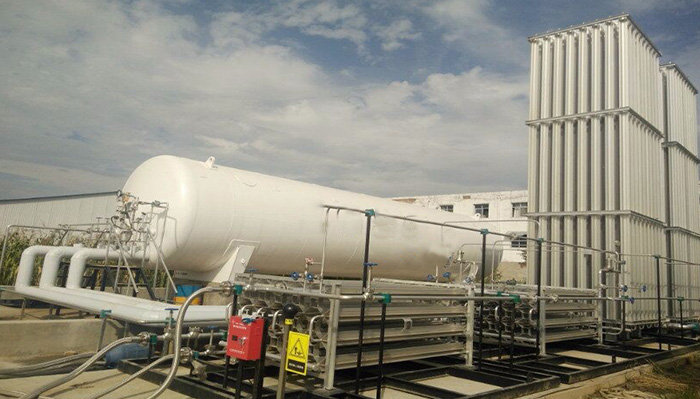Product Category
Pre-cooling method and pre-cooling precautions for LNG storage tanks
Date: Nov 08, 2019

First, how to pre-cool the LNG storage tank?
(1) Pre-cooling with low temperature nitrogen gas. Check the integrity of the unloading hose, and there are no rain, garbage and other debris in the pipe. Connect the hose to the tanker and check that the connection is secure. Raise the tank pressure, open the tank valve, check the hose connection for leaks. Slowly fill the LNG storage tank with low-temperature nitrogen gas. When the pressure of the storage tank rises to 0.2Mpa, close the unloading valve of the unloading station. After the LNG storage tank is insulated for 15 minutes, open the gas phase manual venting valve of the storage tank, evacuate the nitrogen, and repeatedly raise and lower the pressure. get on. The gas is discharged by measuring the full valve, and the temperature is measured by a thermometer, thereby judging the internal temperature of the tank. When it reaches the expected value, the gas pre-cooling work is completed. (2) Pre-cooling with liquid nitrogen. (3) Use of low-temperature nitrogen for venting. When liquid nitrogen is pre-cooled, low-temperature nitrogen gas needs to be vented through the gas phase tube. These low-temperature nitrogen gas can be pre-cooled by other gas-phase pipes connected to other tanks, thereby saving liquid nitrogen.
Second, how to pre-cool LNG storage tank with liquid nitrogen?
During the pre-cooling of the LNG storage tank, it was first pre-cooled with low-temperature nitrogen, followed by pre-cooling with liquid nitrogen using the following procedure.
(1) Empty the tank pressure to a slight positive pressure, close the lower inlet valve and the level gauge balancing valve, and open the level gauge.
(2) Slowly open the tanker liquid phase method to a small opening degree, slowly close the small tank car gas valve, so that a small amount of liquid nitrogen enters from the upper part of the tank. Control the opening of the dumper valve, slightly open a small opening to maintain the pressure at 0.3Mpa. When the tank pressure rises to 0.2~0.3Mpa, close the unloading station valve in time, open the LNG storage tank gas phase manual vent valve to relieve pressure, and repeat the operation.
(3) The gas is released by measuring the full valve. When the temperature reaches a certain value or the liquid level indicator has a liquid level display, the front and rear valves of the lower liquid inlet emergency shut-off valve can be slowly opened, and the liquid is fed up and down at the same time. During the liquid inlet process, the tank pressure should be closely observed and recorded to prevent the pressure from rising; when the pressure rises, the lower inlet valve should be closed in time. Feel the temperature of the outer body of the tank by hand and confirm that there is no problem with the tank.
(4) When the level gauge of the LNG storage tank reaches a certain value, the liquid is terminated.
(5) Close the tank liquid phase valve, open the tank gas valve, and purge the tank discharge line.
(6) Close the tank valve and the unloading station discharge valve, remove the hose, pay attention to light handling, and unrelated personnel should avoid it. After closing the dumper valve, the liquid between the valve and the check valve should be emptied.
(7) Simultaneously close the tank manual gas venting valve and the front hand valve of the lower liquid inlet emergency shut-off valve of the tank. When the unloading LNG pipeline returns to normal temperature, close the inlet valve of the upper tank.
(8) Precooling the supercharger, the air bath type vaporizer and the low temperature pipeline by using liquid nitrogen in the LNG storage tank.
3. What are the main safety and safety inspection contents that should be paid attention to when the LNG storage tank system is pre-cooled?
When pre-cooling the LNG storage tank system, the following safety precautions should be noted:
(1) Pay attention to the valve closing sequence during operation, and it is strictly forbidden to block the cryogenic liquid, because the absorption of external heat by liquid nitrogen in the confined space will cause the pressure to rise sharply;
(2) Pay attention to check whether there is leakage at the hose connection, and the unrelated personnel should evacuate;
(3) Pay attention to observe the pressure rise of the pipeline and the storage tank;
(4) Pay attention to whether there is frost after checking the safety valve.
When pre-cooling the LNG storage tank system, the following inspections should be noted:
(1) Check the low temperature material for low temperature cracking;
(2) Check the welded parts of the low temperature pipe for cracks, especially the welded parts of the flange;
(3) Check the pipe shrinkage and tube support changes;
(4) Check the tightness and flexibility of the cryogenic valve to confirm whether it is frozen;
(5) Check whether the flange connection is leaking, and whether the bolt is reduced due to shrinkage;
(6) Liquid nitrogen is placed in the LNG storage tank for 2~3d, and the liquid level change and pressure rise are observed. At the same time, the change of the vacuum degree of the storage tank before and after the pre-cooling of the storage tank is detected, and the performance of the storage tank is comprehensively evaluated.
(1) Pre-cooling with low temperature nitrogen gas. Check the integrity of the unloading hose, and there are no rain, garbage and other debris in the pipe. Connect the hose to the tanker and check that the connection is secure. Raise the tank pressure, open the tank valve, check the hose connection for leaks. Slowly fill the LNG storage tank with low-temperature nitrogen gas. When the pressure of the storage tank rises to 0.2Mpa, close the unloading valve of the unloading station. After the LNG storage tank is insulated for 15 minutes, open the gas phase manual venting valve of the storage tank, evacuate the nitrogen, and repeatedly raise and lower the pressure. get on. The gas is discharged by measuring the full valve, and the temperature is measured by a thermometer, thereby judging the internal temperature of the tank. When it reaches the expected value, the gas pre-cooling work is completed. (2) Pre-cooling with liquid nitrogen. (3) Use of low-temperature nitrogen for venting. When liquid nitrogen is pre-cooled, low-temperature nitrogen gas needs to be vented through the gas phase tube. These low-temperature nitrogen gas can be pre-cooled by other gas-phase pipes connected to other tanks, thereby saving liquid nitrogen.
Second, how to pre-cool LNG storage tank with liquid nitrogen?
During the pre-cooling of the LNG storage tank, it was first pre-cooled with low-temperature nitrogen, followed by pre-cooling with liquid nitrogen using the following procedure.
(1) Empty the tank pressure to a slight positive pressure, close the lower inlet valve and the level gauge balancing valve, and open the level gauge.
(2) Slowly open the tanker liquid phase method to a small opening degree, slowly close the small tank car gas valve, so that a small amount of liquid nitrogen enters from the upper part of the tank. Control the opening of the dumper valve, slightly open a small opening to maintain the pressure at 0.3Mpa. When the tank pressure rises to 0.2~0.3Mpa, close the unloading station valve in time, open the LNG storage tank gas phase manual vent valve to relieve pressure, and repeat the operation.
(3) The gas is released by measuring the full valve. When the temperature reaches a certain value or the liquid level indicator has a liquid level display, the front and rear valves of the lower liquid inlet emergency shut-off valve can be slowly opened, and the liquid is fed up and down at the same time. During the liquid inlet process, the tank pressure should be closely observed and recorded to prevent the pressure from rising; when the pressure rises, the lower inlet valve should be closed in time. Feel the temperature of the outer body of the tank by hand and confirm that there is no problem with the tank.
(4) When the level gauge of the LNG storage tank reaches a certain value, the liquid is terminated.
(5) Close the tank liquid phase valve, open the tank gas valve, and purge the tank discharge line.
(6) Close the tank valve and the unloading station discharge valve, remove the hose, pay attention to light handling, and unrelated personnel should avoid it. After closing the dumper valve, the liquid between the valve and the check valve should be emptied.
(7) Simultaneously close the tank manual gas venting valve and the front hand valve of the lower liquid inlet emergency shut-off valve of the tank. When the unloading LNG pipeline returns to normal temperature, close the inlet valve of the upper tank.
(8) Precooling the supercharger, the air bath type vaporizer and the low temperature pipeline by using liquid nitrogen in the LNG storage tank.
3. What are the main safety and safety inspection contents that should be paid attention to when the LNG storage tank system is pre-cooled?
When pre-cooling the LNG storage tank system, the following safety precautions should be noted:
(1) Pay attention to the valve closing sequence during operation, and it is strictly forbidden to block the cryogenic liquid, because the absorption of external heat by liquid nitrogen in the confined space will cause the pressure to rise sharply;
(2) Pay attention to check whether there is leakage at the hose connection, and the unrelated personnel should evacuate;
(3) Pay attention to observe the pressure rise of the pipeline and the storage tank;
(4) Pay attention to whether there is frost after checking the safety valve.
When pre-cooling the LNG storage tank system, the following inspections should be noted:
(1) Check the low temperature material for low temperature cracking;
(2) Check the welded parts of the low temperature pipe for cracks, especially the welded parts of the flange;
(3) Check the pipe shrinkage and tube support changes;
(4) Check the tightness and flexibility of the cryogenic valve to confirm whether it is frozen;
(5) Check whether the flange connection is leaking, and whether the bolt is reduced due to shrinkage;
(6) Liquid nitrogen is placed in the LNG storage tank for 2~3d, and the liquid level change and pressure rise are observed. At the same time, the change of the vacuum degree of the storage tank before and after the pre-cooling of the storage tank is detected, and the performance of the storage tank is comprehensively evaluated.
Last article:
Next article:
Send Your Inquiry
We not only provide a good product, but also provide high quality service. If you are interested in our products,
you can contact us in the following ways.
you can contact us in the following ways.















































































































